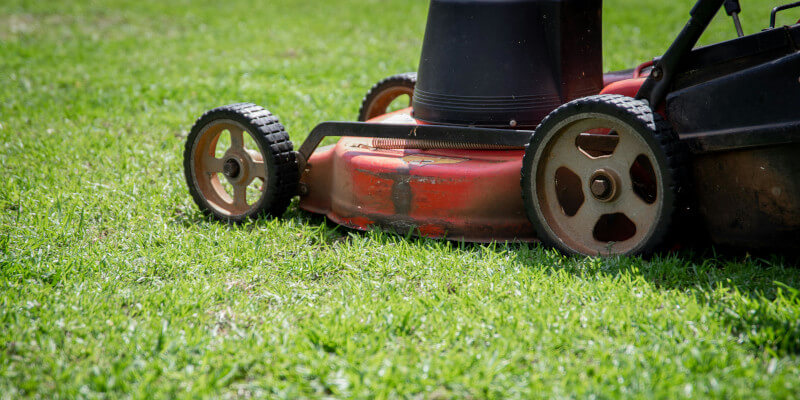Welcome to Your New Lawn: The First 30 Days Matter
Why Sod Needs Special Attention Right Away
Laying new sod is like hitting the reset button on your lawn — but what happens next is just as important as the installation itself. Those first few weeks are when your new turf starts to root, adjust, and establish itself in its new home. A little know-how goes a long way in turning that fresh roll of green into a lush, resilient lawn.
The Sod Establishment Window: What’s Happening Underneath
Right after installation, the sod’s roots are shallow and vulnerable. For the first two weeks, the sod is relying heavily on the moisture and nutrients in its new environment. During this “establishment window,” your job is to help it connect with the soil beneath it — so it can grow deep roots, resist stress, and thrive long-term.
The First Mow: Timing, Technique & Mistakes to Avoid
When Should You Mow New Sod?
The first mow should happen once your sod has rooted well enough that it won’t shift under light pressure. Usually, that’s around <strong>14 days</strong> after installation — but you can do a quick “tug test” to be sure. If the sod resists pulling and feels anchored, it’s ready for its first trim.
How to Cut Without Compromising Root Growth
The key is to cut just the tips — removing no more than one-third of the grass height. Avoid mowing when the lawn is wet or soggy, as this can damage the turf and compact the soil. Use a sharp mower blade to ensure clean cuts rather than tearing the grass, which can stress the sod and invite disease.
Mower Settings & Best Practices for First Cuts
Set your mower at its highest setting for the first few mows. This allows the grass blades to keep photosynthesizing and driving energy into root development. As the sod matures over the next few weeks, you can gradually lower the mowing height to your preferred level.
Feeding Your New Lawn: Fertilizing for Strong Roots
Choosing a Starter Fertilizer That Fits Your Sod Type
Starter fertilizers are designed to promote root growth rather than top growth — which is exactly what your new sod needs. Look for a balanced or phosphorus-rich blend (like 10-10-10 or 15-20-10) and check that it’s suitable for your specific sod type (e.g., Bermuda, Zoysia, or St. Augustine).
Timing Your First Feeding: Not Too Soon, Not Too Late
Apply your first fertilizer 3–4 weeks after installation, once the sod has taken root. Applying fertilizer too early can stress new sod or cause runoff if the roots aren’t developed enough to absorb nutrients. Water thoroughly after applying to help nutrients soak into the root zone.
Long-Term Fertilizer Planning for Charleston Lawns
Charleston’s warm-season grasses thrive with 2–4 feedings per year. After the initial feeding, plan for another application in mid-summer and one in early fall before your lawn begins to slow down. Avoid fertilizing during periods of drought or extreme heat unless you’re equipped with irrigation to support uptake.
Watering Wisely: From Saturation to Sustainability
Daily Watering Tips for the First Two Weeks
Immediately after installation, your sod should be watered 2–3 times per day, keeping the top few inches of soil consistently moist. Watering in the <strong>early morning and early afternoon</strong> is best — avoid watering in the evening, which can lead to fungal issues.
Signs of Overwatering vs. Underwatering
- Overwatering: Mushy or soggy sod, visible mold or mushrooms, yellowing grass.
- Underwatering: Dry, curling blades, gaps forming between seams, visible footprints that don’t bounce back.
Adjusting Your Schedule Based on Weather
As the sod begins to root (around week 3), reduce frequency and increase depth. Water every 2–3 days and aim for 6 inches of soil penetration. Rainy days? Skip irrigation. Hot and dry? You might need to supplement more often.
New Sod FAQ: Answers Every Homeowner Needs
Can I Walk or Play on My New Sod Yet?
Hold off on heavy foot traffic for at least 2–3 weeks. If you must walk across it, use stepping stones or boards to distribute weight. Pets and kids should avoid it until the roots have firmly established.
Why Is My Sod Turning Yellow in Spots?
Yellowing can be caused by overwatering, poor drainage, or fertilizer burn. Check your watering schedule, test for standing water, and make sure you didn’t fertilize too early or heavily.
How Long Before It’s Fully Rooted?
Most warm-season grasses in Charleston will begin rooting within 10–14 days and be fully established by 4–6 weeks. Cooler weather may slow this down a bit.
Do I Need to Aerate, Dethatch, or Treat for Weeds?
Not during the first season. Let the sod establish without stress. Once the lawn is mature (after 6–12 months), consider annual aeration. Weed control can start after 6–8 weeks, but always use products labeled safe for new lawns.
Is Sod Maintenance Different by Season?
Yes. During hot summers, increase irrigation and mow slightly higher. In fall, focus on feeding and prepping for winter dormancy. Winter requires minimal input unless Charleston gets an unusually dry spell.
Conclusion
Healthy Sod Starts with Smart Care
A beautiful lawn isn’t built in a day — but with the right start, your new sod can deliver instant curb appeal and long-term performance. Mow with care, fertilize wisely, water consistently, and stay alert to early signs of trouble.
Let Henry Landscaping Help Your Lawn Thrive
From professional sod installation to expert lawn maintenance guidance, Henry Landscaping is here to make your green goals a reality. Contact us for customized care plans, irrigation help, or a free consultation on your next outdoor project.
Related Articles
How to Measure and Prep Your Yard for Sod Installation
Thinking about transforming your lawn with new sod? Smart move. But before the first roll hits the...
The Hidden Dangers of Laying Sod Over Existing Grass
Sod installation offers homeowners an immediate solution to achieving a lush, green lawn. By...
Optimal Seasons for Laying Sod: Spring vs Fall
Temperature plays a critical role in how well sod establishes itself. Cool-season grasses, such as...
The Ultimate Guide to Watering Sod: Optimal Amounts and Schedule for a Lush Lawn
Sod is pre-grown grass that is cultivated and harvested with a layer of soil held together by...

